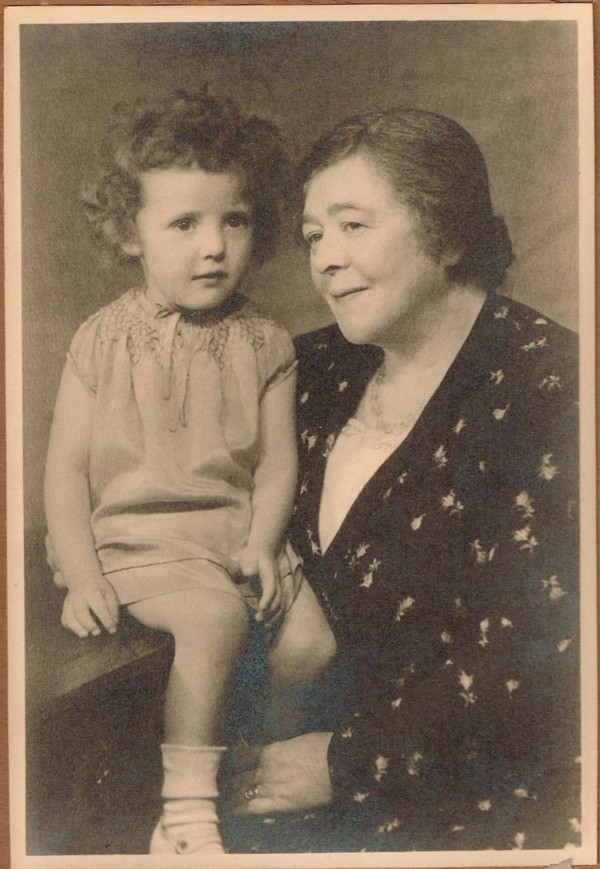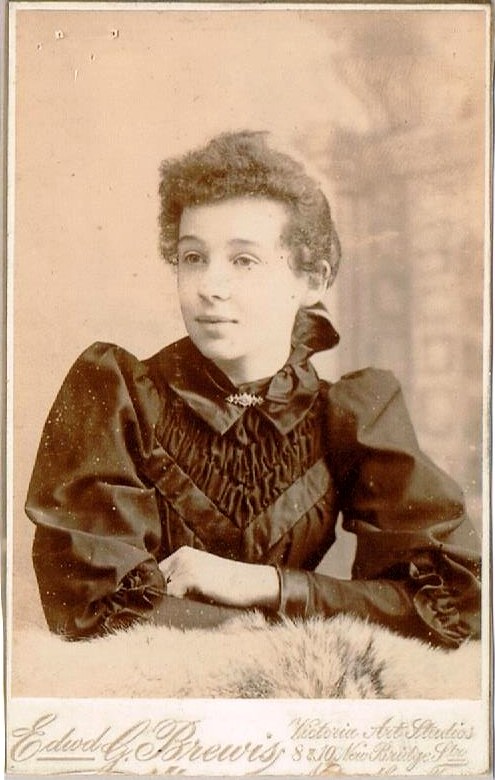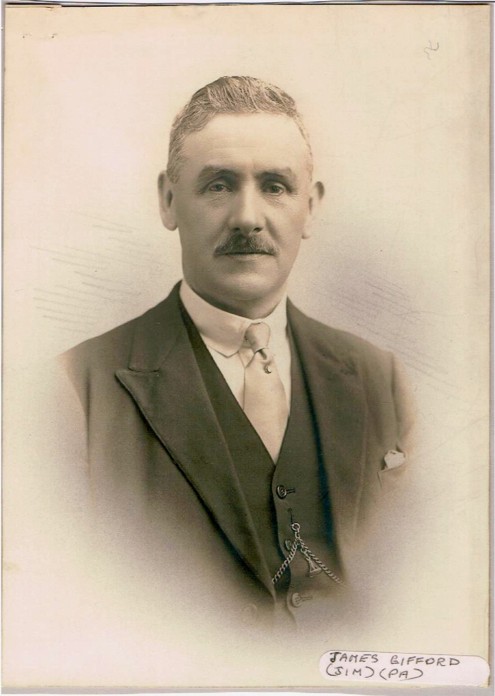All my ancestors are now dead. I'm an orphan. So for this history I've had to rely on my recollections a small pile of documents left by my mother. These include short biographies of several of her relatives. Following the female line; these recollections briefly span the two world wars; to the present.
Elsewhere on this site is Jordan's year ten report of interviews she conducted with her great-grandmother, before she died, her grandmother and her mother [read more... ]. Jordan's great-grandmother was a decade younger than my grandmother and brought up in Australia in totally different circumstances but there are some striking similarities.
And so to my mother and her family.
Politics ran in the female strand of the family; as plumbing did in the male strand.
Great-Grandparents - the 19th Century
My great-grandmother (Jane Dodds Gifford 1873-1935) was the daughter of a flour merchant, Robert Carmichael and Amelia Carmichael (nee Dodds).

This photographic portrait was made circa 1878. I still have the original in an elaborate frame.
My great-grandmother Jane as a child with her mother Amelia Carmichael
Jane married my great-grandfather (James Steel Gifford 1872-1946) on 24th October 1894 when she was 21 and he was 22.
They had lived eight houses apart in Sarah St, Shieldfield Newcastle-upon-Tyne and no doubt met at church. In the 1960's Sarah St. was condemned as slum housing and there is a photograph taken in 1958, prior to its demolition, in the Newcastle Library. The entire area was demolished and replaced by housing estate flats.
James' family had moved from Edinburgh Scotland to Newcastle when he was a boy. His mother lived to a great age but little is known of his father. When they were married he indicated that his father's profession was 'labourer' but he believed he had a different natural father and as an adult often attempted to track down his real father in Scotland.
He was initially a journeyman plumber and successfully built his own business. When my grandmother was a baby they lived in Howard St in Byker near to his business in Coquet St, in the shadow of the Byker Bridge; a short five minute walk from home. Today the site is being redeveloped. Their first house was also demolished in the 60's. But they soon moved to a new larger terrace house in Rokeby Terrace. It is a pleasant suburban street by English standards as each house has a front bay window and is set back from the street by a small garden. It can be seen in Google street view today. It's a 40 minute walk, or 8 minutes by car, from the business. Jane's sister was moved into the house next door to keep her company.
They had four children (Joseph, Amelia, Orick and Violet) but Joseph died in infancy.
 |
 |
A photographic portrait of Jane made around 1894. And my great-grandfather James Steel Gifford (Jim - Pa)
My mother wrote of her:
Jane (Jinnie), [my grandmother] was a typical Victorian wife and mother. She adored her husband, in spite of his frequent absences and infidelity, and lived for him, her children, her church and the Conservative Party.
Her sister was her constant companion. They lived next door to each other and went everywhere together. They belonged to what must have been one of the first branches of the Womens' Conservative Party to be formed after women's suffrage. The women had a separate entity to the men with their own party branches and hierarchy.
Every afternoon after the mid-day meal... they emerged from their homes to go to the Mothers Union at their church, a Party meeting or the 'Pictures'. They embraced the silent movies and then 'talkies' with joy, They were known to every commissionaire at every cinema in Newcastle and seldom had to wait in a queue for admittance.
A big event was the annual Church Bazaar when they were in charge of the Work Stall. To this end they bought whole bolts of material and spent months sewing it into a range of men’s and women’s clothing.
Christmas and New Years Eve was always spent at her home and she preserved the rites of New Years Eve scrupulously, not only the 'first footing' by a dark man but the payment of all bills, cleaning of the home, fresh linen on all beds and bathroom and the soiled linen washed ironed and put away. The only time I saw her annoyed was when someone forgot the rules and washed their hands at 11.45 p.m.
My personal recollection of my grandmother was of a gentle lady who always was there for me in the somewhat stormy relationship I had with my mother. Her death when I was twelve was the first real loss in my life and had a profound effect on me.
Jane was devoted to her husband throughout his life and willingly overlooked his openly kept mistress, Kitty Sims, who was also his office manager at the business. He was charming and much liked by many ladies; including my mother who was fond of her grandfather and secretly continued to visit him after her mother fell out with him.
She wrote of him:
"For some years he had a large Ford touring car which he drove with considerable flair. He was always impeccably dressed and had a taste for pearl &/or diamond tiepins and rings.
He loved animals and there was always a stray cat and dog or two which he had rescued and for which he found homes, all the cats were called Jiggers a name which remained in our family for some cat generations. He also kept a guard dog usually a Newfoundland, at his business premises, which would eat an intruder but which was putty in his hands.
These premises were at the end of and partially under a culvert which joined the suburb of Byker to the City and which carried a road and tram tracks. His office was at road level and it is typical of his sense of humour that he had a WC mounted on the roof to advertise his business...
He enjoyed the good things of life and spent a lot of time away from home at horse races. He was always at home for Christmas but spent every New Year at the Hogmanay celebrations in Edinburgh.
Although a good provider for his wife and three children he also had a mistress who remained with him until his death.
My personal recollection of my grandfather is of a generous, kind man... After my grandmother's death my mother fell out with him for some years but I used to visit him from time to time without her knowledge. He came to my wedding and I took my first child Richard to see him on what turned out to be his deathbed."
When she was a teenager his eldest daughter, my grandmother, Amelia Louisa Storey (1896-1982) known as Minnie, found his blatant infidelity hard to take. One day when her father was away on business, Kitty sent the office boy around to the house with a pay packet containing the housekeeping money. Minnie answered the door and infuriated by the insult of a pay packet sent to her mother, went around to the factory and strangled her. Leaving Kitty unconscious Grandma marched, or perhaps cycled, back home and announced 'I've murdered Kitty Simms'. Fortunately, Kitty had just fainted or was foxing. I've heard several versions of this story from my mother, Grandma herself, and my mother's cousin. It was told as being typical of Grandma's approach to life in general.
After my great-grandfather's death Kitty Sims, who apparently remained attractive, emigrated to Canada where she married (a plumber?).
Minnie in turn married a plumber, Alan Storey, my grandfather (1894-1958). Alan's father (George Mattison Storey 1858-1933) like James Gifford had started as a journeyman plumber and built his own plumbing and hardware business. But unlike her other grandfather my mother found him stern and unapproachable. His father (Robert) had been a carpenter.
She wrote of him:
"(he) was a typical Victorian father - a martinet who believed in "spare the rod and spoil the child" and that his children were his to order as he pleased... (who) apprenticed each of his 5 sons to a trade appropriate to his business, himself being the Master. There was no appeal against this...
The four children of his second marriage all passed the entrance examination to Grammar School (ie secondary education) but only the eldest boy Clifford and youngest girl Isobel (Poppy) were allowed to take up the scholarship. No subsequent attempts to break out of the mould were allowed, in Alan's case both an opportunity to take the entrance examination to Teachers' College and to become articled to an accountant were foiled simply by refusing to sign the necessary papers.
My personal remembrance of my Grandfather is of an irascible old man who rarely smiled or offered any expression of affection.
It is interesting to note that of the fourteen children born to George Mattison Storey's eight children, all had secondary education and eight continued to tertiary level two becoming engineers, one an accountant, one a bank manager, two teachers, one a doctor and one a professor of applied mathematics."
Alan and his brother Clifford initially took over their father's business; to which they had previously been apprenticed.
My mother wrote:
Following their father's death Alan and Clifford set about rescuing the business. Clifford, who had been in an engineering regiment during the War was a qualified electrician. They put a competent manageress into the shop and widened its scope to include electrical appliances, china and glassware. They employed a carpenter and apprentices and journeymen in their own trades and tendered for work in new building projects as well as the home repair business, which their father had relied on. After various unhappy experiences with tenants in the house it was decided that Alan and Amelia should live there and so when I was twelve 98 Heaton Road became our home. Some years of growing prosperity followed, overshadowed by the threat of war and in 1939 Britain declared war on Germany.
The shop at 98 Heaton Road is still there and now sells baths, bathroom furniture and fixtures. How little things change. But their home behind and over the shop has become student accommodation.
